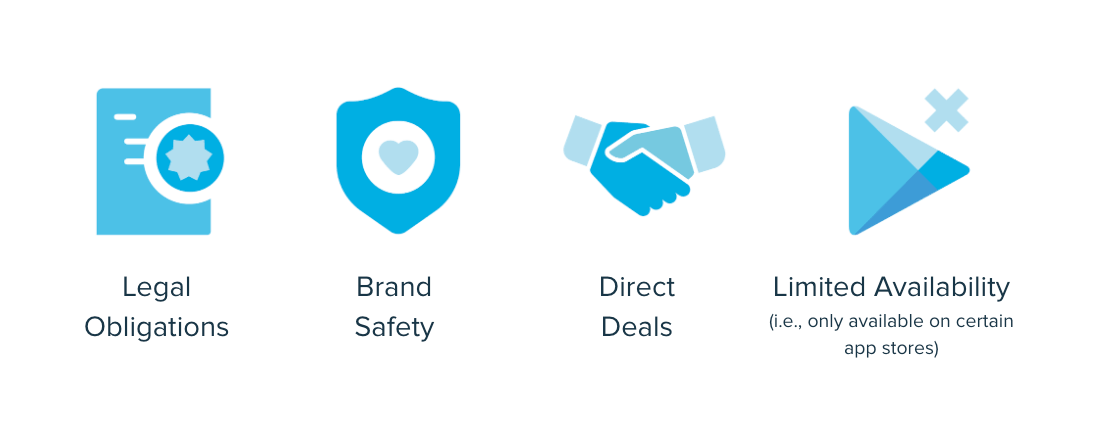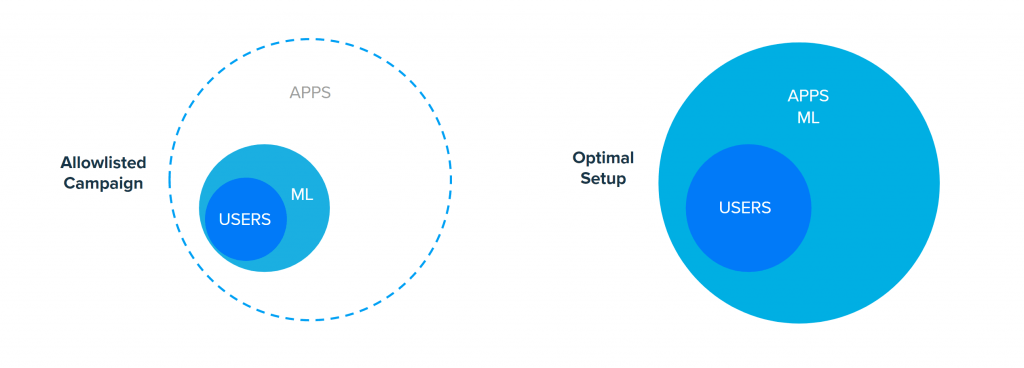
Is allowlisting helpful for ad campaigns?
When campaign-performance expectations don’t manifest into the desired realities, it’s natural to want to take back the reins and pivot spend away from poor-performing inventory. While searching for the “secret sauce” of programmatic performance, you may decide to experiment with allowlisting.
Allowlisting is a practice that limits spend to a specified list of inventory (or directs a certain portion of spend towards inventory that’s expected to perform better). By manually pushing spend toward top-performing source apps or devices, advertisers hope to achieve better performance and rein in unruly KPIs. After all, why waste spend exploring new inventory when you’ve already identified a tried and true strategy?
Admittedly, allowlisting is beneficial – if not necessary – for advertisers concerned about brand safety, legal obligations, and direct deals. Apps that are limited to certain app stores will also need to allowlist users with access to those app stores; in other words, an app that only runs on the Samsung Galaxy Store shouldn’t waste spend targeting other Android users.

That said, programmatic advertising is not a one-size-fits-all industry, and what works well for one partner may not work well for another. Different data, ML, bidding techniques, and a wide variety of other factors can lead to different performance among advertising partners.
Our highly efficient ML takes hundreds of features into consideration, including source app and exchange, to bid the right price, on the right user, at the right time to to find and deliver the best users and hit KPIs. Allowlisting prevents our ML from exploring all available inventory, discovering the highest-converting users, and optimizing and scaling on the best-performing source apps.

This creates the perfect recipe for missed opportunities and poor campaign performance. For starters, targeting a specific list of source apps or devices prevents our ML from uncovering new, performant inventory. In an ever-changing industry like ad tech, it’s crucial to have a model that can optimize towards the latest and greatest inventory as source apps come and go from the market. Along the same lines, allowlisted source apps might perform well initially but then degrade at an increased scale. Because we are bidding on a smaller pool of source apps or device models, the ML has to increase bids to win more impressions. This drives up CPMs and trickles down to poor CPI, CPA, and ROAS performance.
Liftoff conducted multiple experiments across hundreds of source apps over the course of eight months to understand how allowlisting impacts in-app advertising campaigns.
None of the experiments resulted in a positive impact on campaign performance.

In total, 83% of experiment campaigns saw degraded performance on their allowlisted source apps. D7 ROAS decreased 136% and CPIs increased 26% on average on tested source apps. Increasing spend on specific source apps ultimately did not help advertisers reach their growth targets or scale.
In a similar experiment where advertisers allowlisted their campaigns to only include Liftoff’s top 100 source apps, none of the allowlisted campaigns saw a positive impact as a result of allowlisting. Additionally, 69% of the allowlisted campaigns performed significantly worse than their non-allowlisted counterparts.
Although allowlisting can make sense for some advertisers with brand, legal, and other advertising restrictions, it’s best to avoid allowlisting as an optimization lever. Forcing spend on performant source apps already spending at scale does not yield stronger performance, and manually limiting inventory will more likely hurt your campaigns than help them.
While the hands-off approach to programmatic advertising can feel unpredictable and confusing at times, trusted partners like Liftoff have spent over a decade perfecting our ML models so you can confidently target the best users for all your in-app advertising goals. By openly exploring inventory across the now 7+ million apps worldwide, our ML can rapidly adjust to the volatile marketing landscape and find the highest-quality users at the cheapest cost for your UA, RE, and app-to-web campaigns.
Let’s make the most of these tips! Contact your account manager to learn more about how Liftoff can help you reach your growth acceleration goals or get started today.